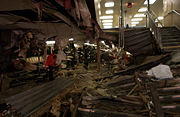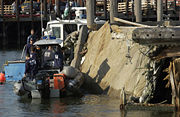
2003 Staten Island Ferry crash
Encyclopedia



Staten Island Ferry
The Staten Island Ferry is a passenger ferry service operated by the New York City Department of Transportation that runs between the boroughs of Manhattan and Staten Island.-Overview:...
vessel Andrew J. Barberi
Andrew J. Barberi
The MV Andrew J. Barberi is one of two Barberi-class ferry boats operated as part of the Staten Island Ferry between Manhattan and Staten Island in New York City....
crashed full-speed into a concrete pier
Pier
A pier is a raised structure, including bridge and building supports and walkways, over water, typically supported by widely spread piles or pillars...
at the St. George ferry terminal. Eleven people were killed and 71 injured, some critically.
The accident
The 310 feet (94.5 m) ferry was at the end of its 5 miles (8 km), twenty-five-minute trip from ManhattanManhattan
Manhattan is the oldest and the most densely populated of the five boroughs of New York City. Located primarily on the island of Manhattan at the mouth of the Hudson River, the boundaries of the borough are identical to those of New York County, an original county of the state of New York...
to St. George, Staten Island
St. George, Staten Island
St. George is a neighborhood on the northeastern tip of Staten Island in New York City, where the Kill Van Kull enters Upper New York Bay. It is the most densely developed neighborhood on Staten Island, and the location of the administrative center for the borough and for the coterminous Richmond...
. On board were approximately 1,500 passengers, well below the maximum capacity of 6,000. Winds were particularly heavy that afternoon, with gusts of over 40 mph (64.4 km/h). The water in New York Harbor was described as "very choppy."
Instead of docking, the ferry angled away from its berth and slammed full-speed into a concrete maintenance pier, a concrete platform supported by pilings. The pier ripped into the ferry's starboard side and tore into the boat's main deck where many passengers were crowding forward to disembark. As the concrete slab entered the boat, passengers screamed and ran for cover. Some jumped into the 62 °F (16.7 °C) water. The accident left a number of victims trapped in a massive pile of metal, glass, and splintered wood. The accident was the worst in the ferry service's 98-year history. The ferry's hull
Hull (watercraft)
A hull is the watertight body of a ship or boat. Above the hull is the superstructure and/or deckhouse, where present. The line where the hull meets the water surface is called the waterline.The structure of the hull varies depending on the vessel type...
, however, sustained no damage, and the vessel was never in danger of sinking.
On the upper deck, passengers waiting to exit turned and ran in panic as the ferry struck the pier. Following the crash, they could see none of the carnage immediately below them. No announcements were made, and the upper-deck crowd waited in ignorance for twenty minutes, until the vessel was turned around and finally docked at the other end. Even before it reached its berth, rescue workers arrived on shore to assist with the search for survivors.
Fatalities and injuries
Eleven people were killed and 71 others injured in the accident.- All of the fatalities and most injuries were to passengers in the main deck; some passengers on the upper decks were injured during the crowd's panic, and many were treated for shock.
- Among the dead was John P. Healy, a 44-year old father of four who was a survivor of the September 11 attacks.
- Paul Esposito, a 24-year old waiter, had both legs severed below the knee. His life was saved by Kerry Griffiths, a sightseeing 34-year-old pediatric nurse from England, who applied tourniquetTourniquetAn emergency tourniquet is a tightly tied band applied around a body part sometimes used in an attempt to stop severe traumatic bleeding. Tourniquets are also used during venipuncture and other medical procedures. Severe bleeding means the loss of more than 1,000 ml of blood. This flow of blood...
s. - On December 16, 2003, injured victim Debra Castro died, making her the 11th fatality of the accident. She had been in a drug-induced coma for two months.
Aftermath
Mayor Michael BloombergMichael Bloomberg
Michael Rubens Bloomberg is the current Mayor of New York City. With a net worth of $19.5 billion in 2011, he is also the 12th-richest person in the United States...
promptly announced that the crash was an accident, allaying fears of a public still stunned by the 9/11 terrorist attacks, which killed a large number of Staten Island residents. A co-worker claimed to have seen the pilot
Maritime pilot
A pilot is a mariner who guides ships through dangerous or congested waters, such as harbours or river mouths. With the exception of the Panama Canal, the pilot is only an advisor, as the captain remains in legal, overriding command of the vessel....
asleep on duty, slumped over the controls. Two witnesses said the boat seemed to speed up just before the crash.
The ferry's pilot, Richard Smith, attempted suicide
Suicide
Suicide is the act of intentionally causing one's own death. Suicide is often committed out of despair or attributed to some underlying mental disorder, such as depression, bipolar disorder, schizophrenia, alcoholism, or drug abuse...
by slitting his left wrist while still on the boat. He then slipped away so suddenly that he left his house keys. He was found shortly afterward at home, having apparently broken in. Smith had again tried to kill himself, this time by shooting himself twice in the chest with a pellet gun, but survived this second suicide attempt.
It was later determined that Smith had lost consciousness while at the ship's controls. He had taken the painkillers Tramadol
Tramadol
Tramadol hydrochloride is a centrally acting synthetic opioid analgesic used in treating moderate pain. The drug has a wide range of applications, including treatment for restless legs syndrome and fibromyalgia...
and Tylenol PM, both of which can cause drowsiness as a side effect. The city rules required two pilots to be present during docking, but this rule had not been enforced by the management of the ferry service, and Smith had been alone in the pilot house. On August 4, 2004, Smith pleaded guilty to manslaughter
Manslaughter
Manslaughter is a legal term for the killing of a human being, in a manner considered by law as less culpable than murder. The distinction between murder and manslaughter is said to have first been made by the Ancient Athenian lawmaker Dracon in the 7th century BC.The law generally differentiates...
. He was sentenced to 18 months in prison on January 10, 2006. New York's former city ferry director, Patrick Ryan, who had also pleaded guilty to manslaughter, was sentenced to a year and a day on similar charges.
The accident resulted in scores of lawsuits against the city. As of September 2008, the city had paid $54.3 million to the victims and their families, with other lawsuits pending.
The crash was at first said by New York City to be an Act of God
Act of God
Act of God is a legal term for events outside of human control, such as sudden floods or other natural disasters, for which no one can be held responsible.- Contract law :...
, with attorneys arguing that the Department of Transportation
New York City Department of Transportation
The New York City Department of Transportation is responsible for the management of much of New York City's transportation infrastructure...
should not be held responsible for the crash, an argument that disturbed many survivors and New York City residents. City attorneys, citing a 19th Century maritime law, would later argue that the total amount of damages sought against the city should not exceed the cost of the ferryboat. On February 26, 2007, U.S. District Judge Edward Korman rejected this argument and held that the city could not cap damages, writing, "The city's failure to provide a second pilot or otherwise adopt a reasonable practice that addresses the issue of pilot incapacitation was plainly a substantial factor in causing the disaster."
Despite these rulings and a similar, independent federal probation report by officer Tony Garoppolo into the culpability of the ferry service's upper management in which he ruled "the lion's share of culpability in this case as resting with the high level management of the Ferry Service", no other employees of the New York City Department of Transportation
New York City Department of Transportation
The New York City Department of Transportation is responsible for the management of much of New York City's transportation infrastructure...
were prosecuted.
On May 8, 2010, the same boat was involved in another crash. As the ferry approached the St. George terminal, the throttle failed to engage as it prepared to dock and crashed into the dock. The impact caused 37 injuries, one of which was serious.
External links
- NYC ferry crash kills 10, injures dozens - Washington Times
- Ferry Pilot Sentenced - Sydney Morning Herald
- Staten Island Angel Memorial - website dedicated to victims of the accident

